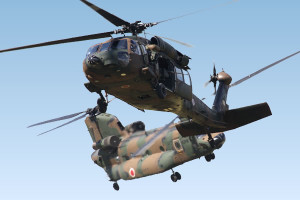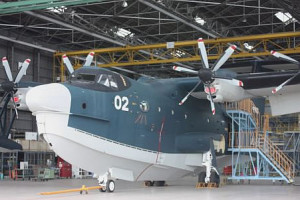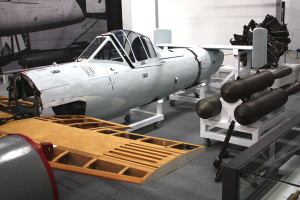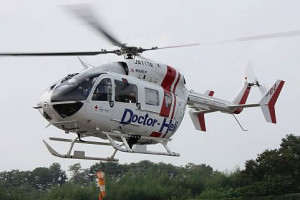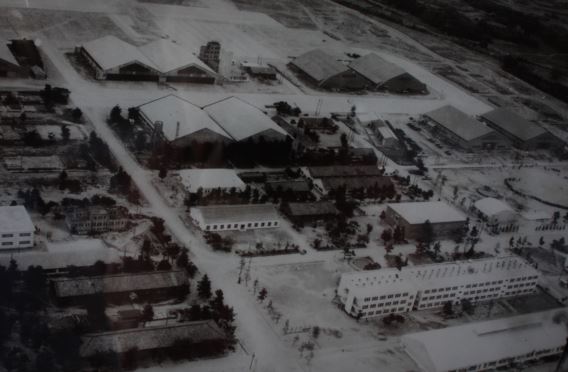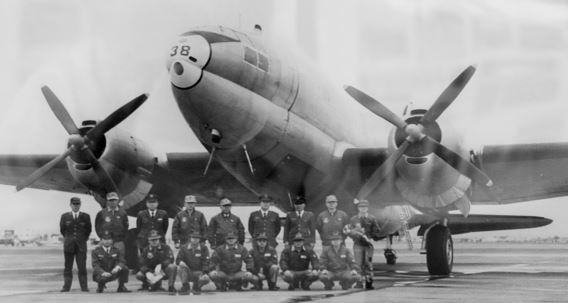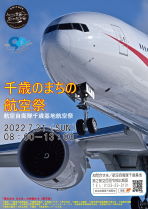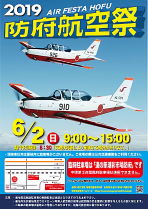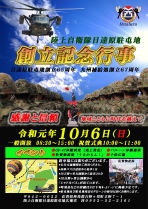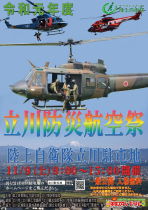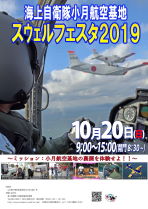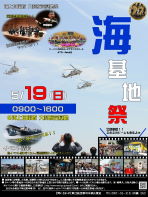JASDF Base Histories
Steeped in aviation history that in some cases pre-dates the service’s formation, JASDF air bases are inextricably linked to the development of aviation in Japan. Comprehensive descriptions of key events in the histories of the following 17 bases and two sub-bases (Akita and Niigata) will be complemented by a wealth of other details and a data box of useful information. The bases highlighted in the following table have been included as examples of the more detailed coverage.
| Akita | Hamamatsu | Kasuga | Miho | Niigata |
| Ashiya | Hofu-Kita | Komaki | Misawa | Nyutabaru |
| Chitose | Hyakuri | Komatsu | Naha | Shizuhama |
| Gifu | Iruma | Matsushima | Nara | Tsuiki |
Initial information is being obtained from the respective base websites, the URLs of which are included in the concluding data box of each entry, and Japanese Wikipedia. Additional factual information, for example from the Japanese aviation press, is being added and cited where applicable as and when time permits.
|
Akita |
Location | Akita Airport, Akita City, Akita Prefecture |
| Established | Jan. 29, 1987 |
Serving as a sub-base of JASDF Misawa AB, Akita houses a search and rescue squadron that operates from a dedicated apron on the west side of Akita airport’s runway.
Agreement was reached with Akita airport’s management company concerning the building of facilities and the operation of an air rescue unit in October 1984. Started in August 1985, detailed preparations were followed by the establishment of a local military presence (Akita JGSDF Army Camp) in January 1986. The Akita sub-base was inaugurated and a detachment formed on January 29, 1987. A Mitsubishi MU-2S search aircraft and a KV-107IIA-5 rescue helicopter were assigned to the unit on March 11, 1987.
Its commanding officer also serving as base commander, the Air Rescue Wing detachment formed on March 25, 1987, to provide air rescue coverage for the northern part of the Sea of Japan.
The apron area was enlarged in 2000, ahead of the arrival of the unit’s U-125A on March 27, 2001; the MU-2A’s last flight took place on February 21, 2002.
On the helicopter side, a UH-60J was assigned for training purposes on March 22, 2004, and the unit officially became a three-aircraft operation on November 1, 2005. This situation lasted until September 10, 2007, when the KV-107IIA-5 was flown for the last time. In the meantime, the heightened level of operations had prompted another round of facility expansion and upgrades in 2006. The unit started to make use of a helicopter crew training ground at Kamioka in the city of Daisen in June of that year.
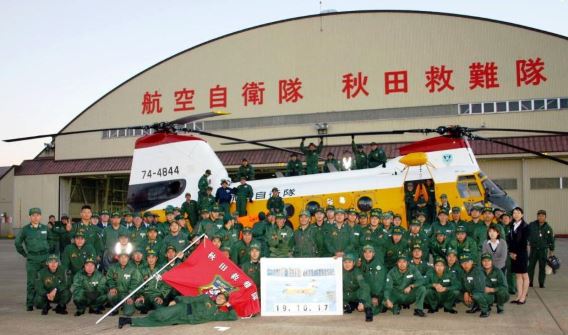 Akita Air Rescue Squadron personnel pose for a photo to bid farewell to the KV-107IIA-5, which
Akita Air Rescue Squadron personnel pose for a photo to bid farewell to the KV-107IIA-5, which
had provided 20 years of sterling service, on October 17, 2007. (Photo: JASDF Akita Sub-Base)
On September 11, 2007, a ceremony was held to mark the dedication of a monument where the spirits of three of the eight crew members who lost their lives in two tragic MU-2S accidents are enshrined. On October 19, 1994, a Hamamatsu-based aircraft crashed when on a test flight; on April 14, 2005, an aircraft struck Mt. Mikagura during a training exercise from Niigata Sub-Base. Attended by bereaved family members, the five Akita-resident members of the public who serve for one year as external base monitors as well as current and former base personnel, memorial ceremonies are conducted on the anniversaries of these events.
 July 16, 2012. The scene inside the Akita ARS hangar on the occasion of the ceremony marking the
July 16, 2012. The scene inside the Akita ARS hangar on the occasion of the ceremony marking the
25th anniversary of the base’s establishment. (JASDF Akita Sub-Base)
The JASDF’s utilization of Akita airport itself dates back to an agreement, signed by the Akita prefectural government and the then Japan Defense Agency (now Ministry of Defense) in 1959, that covered SAR, transport and communications flight operations alone. In more recent years, the terms of the agreement were not contravened even during the Great East Japan Earthquake operations in 2011. At a press conference held in June 2015, however, Akita Governor Norihisa Satake approved the airport’s use by fighter or patrol aircraft, or even the complete handover of its control to the Ministry of Defense, in the event of an emergency and appeared to declare the agreement null and void.
One of the helicopter training exercise scenarios conducted in 2014 involved working in concert with the prefectural disaster relief air unit in the simulated rescue of people stranded on top of a supermarket following a major earthquake.
On September 29, 2014, the Sora no Hi (Aviation Day) event, which included a search and rescue flight demonstration, attracted a then record 1,300 visitors, a far cry from the numbers that attend airshows at the major bases.
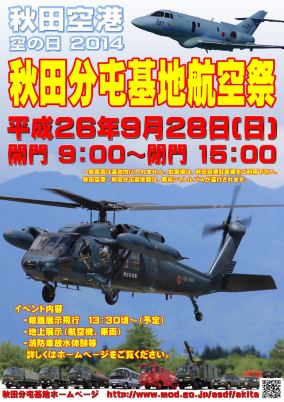 The poster that advertised the 2014 Akita Airport Sora no Hi (Aviation Day) event at Akita Sub-Base.
The poster that advertised the 2014 Akita Airport Sora no Hi (Aviation Day) event at Akita Sub-Base.
A major rescue mission took place on December 23, 2014, when a Panamanian-registered cargo ship ran aground on the beach just south of the port city of Sakata in Yamagata Prefecture. At the request of the local Japan Coast Guard headquarters, the Akita ARW aircraft were scrambled and succeeded in winching 10 of the 18 Myanmar nationals who were on board to safety and bringing them to nearby Shonai regional airport. (The others were rescued by the Yamagata Prefectural Disaster Prevention Aviation Unit.)
In a repeat performance, the first rescue mission of 2016 took place on January 10, when another Panamanian-registered ship ran aground near the Sakata breakwater. Again called upon to assist by the Japan Coast Guard, the Akita UH-60J crew winched 10 ship’s crewmen to safety.
According to the latest (May 2018) running totals posted on the base website, as at January 12, 2016, the Akita ARW detachment had been dispatched on disaster relief missions on a total of 106 occasions and had rescued 415 people.
 Akita Sub-Base Open Day, October 1, 2017 (Photo: JASDF Akita Sub-Base)
Akita Sub-Base Open Day, October 1, 2017 (Photo: JASDF Akita Sub-Base)
Having reached the milestone of its 30th anniversary, on October 1, 2017, the base welcomed 1,613 visitors to an open day again held to coincide with Akita airport’s Aviation Day event, one of several that were held across the country in the autumn. Not blessed with the best of weather, the September 2018 event attracted just 884 people.
 JASDF Akita Sub-Base (Photo [Oct. 2018]: NASA WorldWind via Wikimedia Commons)
JASDF Akita Sub-Base (Photo [Oct. 2018]: NASA WorldWind via Wikimedia Commons)
| Akita Sub-Base | |
| Based unit | Air Rescue Squadron (U-125A/UH-60J) |
| Contact points | Aza Yamakago 23-26, Tsubakigawa, Yuwa, Akita City, Akita Prefecture 010-1211, Japan Tel. +81 (0)18-886-3320 ext. 220 Fax. +81 (0)18-886-3320 ext. 270 Website homepage/2020 (link) |
| Nearest station | Yotsugoya 四ツ小屋 (Ou Main Line 奥羽)本線 /JREast) |
| Japanese Reference Sources | Base website (last accessed May 16, 2018) Base Watching Guide (Ikaros, 1996) Wikipedia 秋田分屯基地 |
|
Ashiya |
Location | Ashiya Town, Onga District, Fukuoka Prefecture |
| Established | (As IJAAF base) April (Dec.?) 1942 (As JASDF base) Feb. 1, 1961 |
A ground-breaking ceremony was held on the site of what was to become the Imperial Japanese Army Air Force (IJAAF) base of Ashiya on November 13, 1939. J-HangarSpace has thus far been unable to discover the reason for the long gap between the work`s completion on May 29 the following year and Ashiya’s inauguration as an air base in April (some sources state December) 1942.
Charged with air defence and thus itself a prime target, the base was used for the operation of a number fighter types, including the Kawasaki Ki-61 Hien (Tony) and its radial-engined counterpart, the Ki-100.
Taken at Ashiya after the war by the famous U.S. Marine Corps photojournalist Joe O’Donnell (1922–2007), a photograph of a Ki-61 from an unidentified unit can be found here [link]. This is possibly an aircraft that was left behind due to technical problems when staging through Ashiya on the way from Chofu airbase in Tokyo to the special attack (kamikaze) base at Chiran, Kagoshima Prefecture.
Amid the constant redeployment of IJAAF squadrons, Ashiya was also used during the working-up stages of newly formed fighter flight regiments (sentai). Formed from the 2nd Chutai (Company), 4th Sentai at Ozuki, Yamaguchi Prefecture, in August 1942, the 248th Sentai had been increased to a three-chutai unit before relocating to Ashiya that December. Initially flying the Nakajima Ki-27 (Nate), the unit converted to the then latest Nakajima Ki-43-II Hayabusa (Oscar) in late July 1943. Following an intense period of day and night training, the unit received orders to deploy to the New Guinea theatre of operations on October 9, 1943; its 33 aircraft departed Ashiya a mere 11 days later.
 A Hayabusa of the 248th Sentai mentioned in the text formed the subject of a 2003 Hasegawa plastic
A Hayabusa of the 248th Sentai mentioned in the text formed the subject of a 2003 Hasegawa plastic
model kit. In his seminal Japanese Army Air Force Camouflage and Markings World War II
(Aero Publications, 1968), Donald W. Thorpe described the bird plumage-like tail marking
as the “seagull” motif of the 77th Sentai. Subsequently identified as being the markings
of the 248th,the shapes were the stylized leaves of reeds, the tips of which spell out the
sentai‘s number. As was common practice, the colour coding of the markings denoted
individual chūtai, in this case white (1st Chūtai), red (2nd) and yellow (3rd).
Units based at Ashiya ostensibly for training purposes were thrown into the fray when the situation demanded, as happened to the 52nd and 59th sentai on August 20, 1944, when the Yawata Steel Works in Kita-Kyushu, Fukuoka Prefecture, came under attack from USAAF B-29s. An ultimately failed attempt to engage the enemy formations again the following night started in tragedy when two 52nd Sentai aircraft, piloted by the unit’s CO Major Takayuki Uchitoku and flight commander Col. Kurine, were involved in a fatal collision on takeoff. The loss of two key pilots did not prevent the Nakajima Ki-84 Hayate (Frank)-equipped 52nd Sentai from departing for the Philippines four days later, on August 25, 1944.
In memory of those times, the on-base resource centre building contains an 8/10th-scale mockup of a Ki-43 bearing the tail markings of the 248th Sentai.
 A Kawasaki Ki-61-Ib (Tony) fighter of the IJAAF’s 149th Shimbutai special attack (kamikaze)
A Kawasaki Ki-61-Ib (Tony) fighter of the IJAAF’s 149th Shimbutai special attack (kamikaze)
unit at Ashiya airfield in the summer of 1945.
(Photo: U.S. Navy National Museum of Naval Aviation via Wikimedia Commons)
In October 1945, the base passed quietly to U.S. military control as a scrap and salvage centre for the mass destruction of Japanese military equipment that followed the end of the Pacific War. This period came to an end in November 1946, when Ashiya was reactivated as an operational base for a succession of U.S. Army Air Force P-51D Mustang and F-82G Twin Mustang units. Due to the runway being ill-suited for fighter operations and some distance from the war zone, Ashiya became home to the by then renamed U.S. Air Force’s bomber and transport units during the Korean War (1950–53).
Budget cutbacks and the need to reposition U.S. forces to Europe resulted in Ashiya being closed and handed back to Japan; some of the base housing dates back to its time under U.S. command.
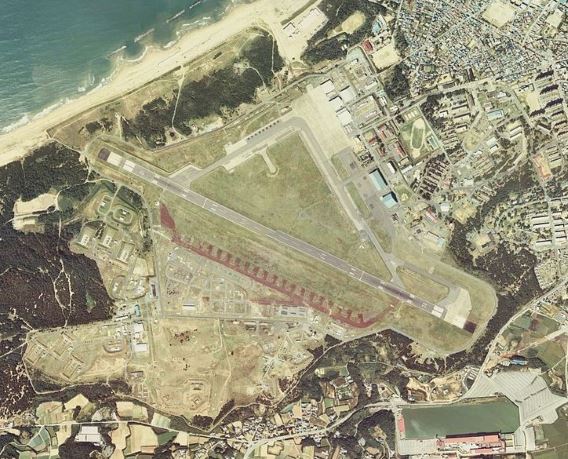 Aerial view of Ashiya AB, taken in 1981. The current runway length is 1,640 meters (5,380 feet).
Aerial view of Ashiya AB, taken in 1981. The current runway length is 1,640 meters (5,380 feet).
(Photo: National Land Image Information [Color Aerial Photographs], Ministry of Land,
Infrastructure, Transport and Tourism via Wikimedia Commons)
Provisional JASDF ground-based units were established in August 1960 and made official three months later, when the U.S. forces vacated the base. Following the official establishment of Ashiya as a JASDF base on February 1, 1961, its facilities were upgraded prior to the arrival of the 3rd Technical School from Gifu and the establishment of an Air Rescue Group detachment in March and July of the following year, respectively. The next phase in the development of today’s Air Rescue Wing unit came in December 1964 with the formation of an Ashiya-designated unit.
 Ashiya AB looking deserted during a period of apron maintenance.
Ashiya AB looking deserted during a period of apron maintenance.
(Photo: Japan Ministry of Defense)
Although by then under JASDF command, the base’s profile was briefly raised overseas by the 1964 film Flight from Ashiya, which was based on the 1959 novel of the same name and starred Yul Bryner and Richard Widmark. An exhibition held in the town from July to November 2014 mentioned that the base was used for some on-location film sets. For the filming of Tora! Tora! Tora!, the account of the attack on Pearl Harbour that was released in 1970, giant open sets of the aircraft carrier Akagi and the battleship Nagato were built on the beach close to the base.
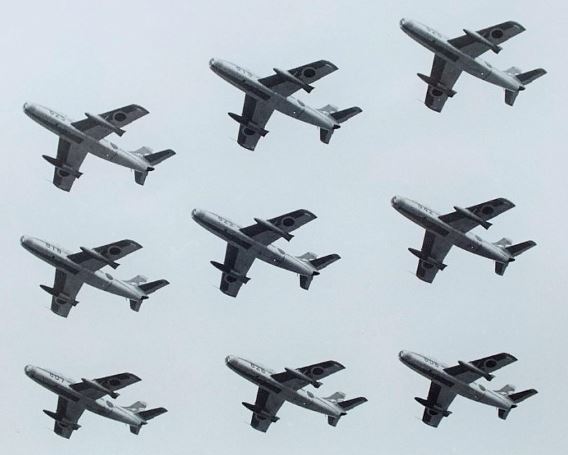 Nine Ashiya-based T-1 pilots demonstrate precision formation flying on the day the
Nine Ashiya-based T-1 pilots demonstrate precision formation flying on the day the
base opened its doors to the public in September 1975. (Photo: Takao Kadokami)
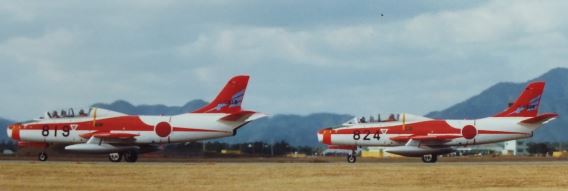 A pair of 13th FTW aircraft lines up for takeoff at Ashiya in November 1989,
A pair of 13th FTW aircraft lines up for takeoff at Ashiya in November 1989,
during the heyday of the T-1 era at the base. (Photo: Takao Kadokami)
 A view across the Ashiya ramp in September 2000 shows one of the then few remaining Fuji T-1s.
A view across the Ashiya ramp in September 2000 shows one of the then few remaining Fuji T-1s.
In October 1962, the 13th Flying Training Wing moved its Fuji T-1 jet trainers from Utsunomiya, Tochigi Prefecture, to start a long association with Ashiya that continues to this day. The trading in of the T-1s for Kawasaki T-4s was completed in March 2001.
 Some of the buildings at Ashiya date back to the U.S. presence in the late 1950s.
Some of the buildings at Ashiya date back to the U.S. presence in the late 1950s.
Today the base is home to around 1,400 permanent personnel (excluding students) and covers an area of 430 hectares (1,060 acres), equivalent to around 92 Tokyo Dome baseball stadiums, making Ashiya the third largest JASDF base.
One of the short ‘day in the life of Ashiya AB’ videos shown on a former version of the base website shows the morning flight that is sent out to check the weather conditions at the designated area prior to the start of the day’s training.
Unexpected recent long-term residents were the Blue Impulse aerobatic display team. Fortunately, the team had happened to be at Ashiya on March 11, 2011, when the Great East Japan Earthquake devastated vast tracts of the Tohoku region, including their Matsushima home base. The team was finally able to return to Matsushima two years later, on March 28, 2013, after having performed a farewell display at Ashiya three days earlier.
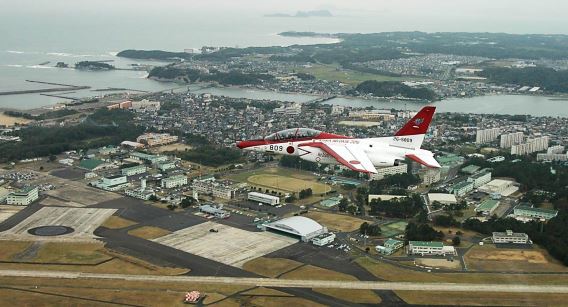 Emblazoned with the wording Ashiya Air Base 2016, a lone T-4 overflies its home base late in 2015.
Emblazoned with the wording Ashiya Air Base 2016, a lone T-4 overflies its home base late in 2015.
The aircraft also carries special markings to commemorate the 15th anniversary of the type’s
association with the base. (Photo: JASDF/Ashiya AB)
 The poster that advertised the airshow commemorating Ashiya AB’s 50th anniversary in 2011.
The poster that advertised the airshow commemorating Ashiya AB’s 50th anniversary in 2011.
 There were two Ashiya shows in 2018, in February (below) and October.
There were two Ashiya shows in 2018, in February (below) and October.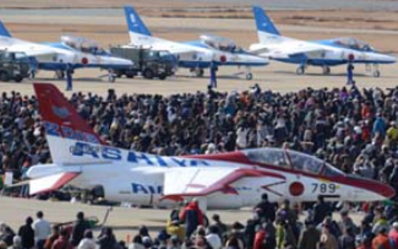 (Photos: [Top] JASDF Public Affairs Office via Twitter @JASDF_PAO; [above] JASDF Ashiya)
(Photos: [Top] JASDF Public Affairs Office via Twitter @JASDF_PAO; [above] JASDF Ashiya)
In October 2016, glorious weather and a Blue Impulse display attracted 54,000 spectators to the Ashiya airshow. In 2018, despite a show being held in both February and October, attendance was steady at 34,000 and 38,000, respectively. In October 2019, however, a combination of factors—the slow return to service of the T-4 fleet that had been grounded due to an engine problem and the resultant absence of the Blue Impulse team as well as the lack of aircraft visiting from bases in eastern Japan due to Typhoon No. 19—resulted in a dramatic decrease to 22,000 visitors on what was yet another fine weather day.
 Part of the annual cycle of events at most SDF air bases are ceremonies to commemorate all those
Part of the annual cycle of events at most SDF air bases are ceremonies to commemorate all those
members who have lost their lives on active service. Taken at Ashiya on November 26, 2021, this
series of photos show (clockwise from top left): the base flag at half-mast; the “missing man”
flypast (the lead T-4 is presumably a photo aircraft); the rifle volley fired in salute; and
the solemn offering of flowers at the base memorial.
(Photos: JASDF Ashiya AB via Twitter @jasdf_ashiya)
 (Above) A view across what would become Ashiya AB during its use for another form of training,
(Above) A view across what would become Ashiya AB during its use for another form of training,
as a driving school for truck drivers. (Below) Against the backdrop of the expanse of their base,
Ashiya personnel form up to mark the diamond jubilee on December 2, 2021. (Photos: JASDF Ashiya AB via Twitter @jasdf_ashiya)
(Photos: JASDF Ashiya AB via Twitter @jasdf_ashiya)
| Ashiya AB | |
| Based units | 1st/2nd Flying Training Sqn, 13th Flying Training Wing (T-4) Air Rescue Squadron (U-125A, UH-60J) |
| Contact points | Ooaza 1455-1, Ashiya Town, Onga District, Fukuoka Prefecture 807-0133, Japan Tel. +81 (0)93-223-0981 (Base PR Group ext. 344) Website homepage/2020 (link) |
| Nearest station | Orio 折尾 (Kagoshima Main Line 鹿児島本線 /Kyushu Railway Co.) Base website recommendation: From the Kagoshima Main Line station at Ongagawa, take the local bus heading for Ashiya-machi 芦屋町and get off at the bus stop named Jieitaimae 自衛隊前 (takes around 20 mins). |
| Japanese Reference Sources | Base website (last accessed May 16, 2018) Base Watching Guide (Ikaros, 1996) Wikipedia 芦屋基地 |
|
Chitose |
Location | Sapporo, Hokkaido Prefecture |
| Established | (As IJNAF base) Oct. 1, 1939 (As JASDF base) Sept. 2, 1957 |
The forces of Nature and an interesting series of events played no small part in dictating the location of Chitose airbase, which nowadays dovetails its operations with those of neighbouring Shin-Chitose airport.
At the start of the Taisho period of Japanese history (1912–26), the rural area around the small village of Chitose—the name literally means “a thousand years”—had been devastated by eruptions from Mt. Tarumae. The volcanic ash having rendered large swathes of land unsuitable for agriculture, by the mid-1920s the villagers had long been struggling to make ends meet.
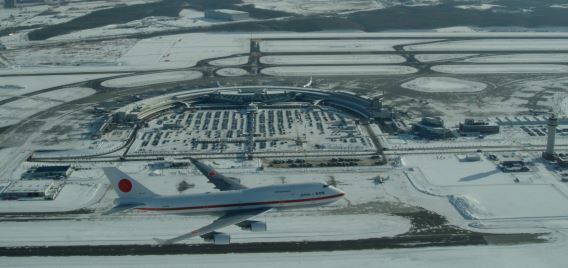 One of the two Boeing 747-400s operated by the 701st Sqn overflies a snow-covered
One of the two Boeing 747-400s operated by the 701st Sqn overflies a snow-covered
Shin-Chitose airport, which also houses its home base. (Photo: JASDF Chitose AB)
Two events helped to sow the seeds of the area’s future as an air base and airport. The first was the opening of a private railway line, with a station at Chitose, in August 1926. The second, in that October, was a visit to Chitose by a group from the Otaru Newspaper Company (today the Hokkaido Shimbun Press), who had travelled by train to tour a salmon farm and wanted to show their appreciation of the local hospitality by having one of their aircraft fly over the village. The villagers had requested that the aircraft land, so that they could get their first close look.
Key factors in this initiative were the foresight of the enterprising village headman, who was looking for ways to utilize the land and to revitalize the area, and the unpaid efforts of the local residents. A village meeting was hurriedly called, and the tourist pulling power of a then still rare appearance by an aircraft resulted in the unanimous decision to go ahead with the building of a landing field. Adults and children alike pitched in to clear an area for a runway 660 feet (200 metres) long and 330 feet (100 metres) wide in all of two days.
The villagers reaped the fruits of their labours on October 22, when the Otaru Newspaper Company’s Mitsubishi R-2.2 biplane Hokkai 1, piloted by Kenjirō Sakai (1903–32) and carrying two passengers, became the first aircraft to land at Chitose. A replica of the aircraft (J-TAWA) can be seen today at the local Meisui Fureai Park, and a statue of Sakai was unveiled at Shin-Chitose airport in October 2002, the 70th anniversary of his tragic death in an air crash off the coast of Tottori Prefecture.
Following the injection of additional financial donations from the village and industry, further efforts on the part of the locals resulted in the expansion of the site to around 37 acres (15 hectares) and the opening of Chitose airfield in October 1934.
In August 1939, the airfield was utilized as a stopping-off point en route to Nome in Alaska by the crew of the specially converted Daimaitōnichi Newspaper Company (today The Mainichi Newspapers) Mitsubishi Type 96 Model 21 Nippon on its record-breaking circumnavigation of the world.
Two months later, on October 1, 1939, an Imperial Japanese Navy Air Force (IJNAF) base was established on the site and the Chitose Naval Air Group formed. A team including a Lt. Kofukuda from the Ohminato Naval Air Group had conducted a survey the previous April, and the village had been officially notified of the decision to build the base in September. This resulted in 320 acres (130 hectares) of village land being given over for the sole purpose of the base, where a naval air group was declared operational on November 1, 1939. Years before, the village headman had reportedly expressed doubts that the land could be used by the military.
The initial main runway extended to 4,000 feet (1,200 metres), with another of the same length intersecting at right angles, but the immediate area was ultimately home to a network of three IJNAF airfields. In the case of what was termed Chitose No. 1, located in what is now the Heiwa district of the city of Chitose, the air base and logistics base ultimately covered a total of 500 acres (200 hectares) and comprised two concrete runways (1,200m/1,400m×80m) and four hangars. In 2005, a study was made of the overgrown remains of the concrete aircraft shelters that were still to be found to the west of the runway; a total of 53 covered and uncovered aircraft shelters had been scattered across the base in its heyday.
Renamed the 703rd Naval Air Group on November 1, 1942, what had been the Chitose Naval Air Group was that month deployed to the Marshall Islands, only to be broken up and finally disbanded the following March.
Although the primary resident unit was subsequently the 41st Naval Air Arsenal, the base was also used by a detachment of two-seat A6M2-K trainer versions of the Zero fighter from the Kasumigaura Naval Air Group in Ibaraki Prefecture. A total of 37 A6M2-Ks remained abandoned there at the end of the war, alongside no less than 93 Yokosuka K5Y (Willow) intermediate training biplanes.
Occupied by U.S. forces from October 1945, the base initially continued its logistics role, adding the role of maintenance sub-base to Johnson AB (today’s Iruma AB). With the onset of the Korean War, Chitose was designated as an emergency landing field. Pages from a USAF-produced guidebook [link] provide an interesting insight. (The F-86F-equipped 4th Fighter Interceptor Wing, the only USAF combat unit to ever be based at Chitose, was commanded by Col. Robert P. Montgomery from 1956 to 1957.)
A civil airport at Chitose was opened to traffic in October 1951, the first services to Tokyo being operated by the then only recently formed Japan Airlines. Joint civil-military operations date back to 1963, when the first Chitose airport terminal building for domestic services was completed. The airport was to commence its life as an international gateway upon its receipt of official port of entry status in 1969, prior to Sapporo’s hosting of the 1972 Winter Olympics.
Back in June 1952, an extensive complex was established at Chitose to house provisional elements of the Keisatsu Yobitai (National Police Reserve).
Nearly three years after the formation of the JASDF in July 1954, a Chitose advance party was formed in May 1957, four months prior to the inauguration of the air base. The first resident JASDF flying units were the F-86F Sabre-equipped 3rd and 4th squadrons of the 2nd Air Wing, which relocated from Hamamatsu during August and were declared operational on September 2, 1957.
The next unit was the Chitose bunkentai (detachment) of the Air Rescue Squadron, which formed in February 1959. This unit was to retain the detachment designation under the renamed Air Rescue Group from July 15, 1961, and be elevated to squadron status under the Air Rescue Group from December 1964 and under the Air Rescue Wing from March 1, 1971. (The overall control of all Air Rescue Wing units passed from Air Defense Command to Air Support Command on March 26, 2013.)
Gradually vacated by U.S. units, Chitose AB was for the most part handed back to Japanese government control under the Japan Defense Agency by the U.S. government in July 1959; the rest remained nominally under U.S. military control until handed back in 1976, although the U.S. base had officially closed on June 30, 1975. During the initial period, the base was a single-runway operation; a second parallel runway was not made available until November 1960. Operations using the third and fourth runways, both of which were added on the east side, commenced in December 1961.
The stop-gap all-weather operations with the F-86D Sabres of the 103rd Sqn, which relocated from Komaki in June 1961, paved the way for Chitose’s long association with the F-104J Starfighter, which lasted from the arrival of the Provisional Starfighter Training Squadron in September 1962 to the disbandment of the 203rd Sqn late in 1983.
 An aerial view of Chitose, taken in 1975. (Photo: National Land Image Information [Color Aerial
An aerial view of Chitose, taken in 1975. (Photo: National Land Image Information [Color Aerial
Photographs], Ministry of Land, Infrastructure, Transport and Tourism via Wikimedia Commons)
Discussions with local groups that pre-dated the arrival of the first F-4EJ Phantoms in 1974 eventually resulted in an east-side runway being moved 3,300 feet (1,000 metres) to the south in 1978 to reduce noise levels.
Having housed units flying each of the JASDF’s mainstay interceptor types, from the F-86F in 1957 to the F-15J from 1983, the forming of the 701st Sqn under the Special Airlift Group in April 1992 added a new dimension to base operations. This milestone was followed by the start of 701st operations at directly adjacent Shin-Chitose Airport in July 1993. The first instance of its kind in Japan, joint use of the runways with civil operations dates back to July 1988, when Shin-Chitose airport opened with a new control tower and a new Runway A. The introduction of Runway B from August 1996 marked the complete physical separation of the civil and military sides of the airport.
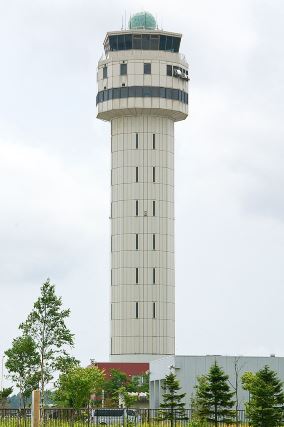 The tower at Chitose, photographed in August 2007. All movements at Shin-Chitose airport and
The tower at Chitose, photographed in August 2007. All movements at Shin-Chitose airport and
the JASDF base are controlled from this building, which has been in operation since June 1988.
(Photo: “J o” via Wikimedia Commons)
As the main JASDF base in Hokkaido, Chitose plays a major role when mounting disaster relief operations. The most recent instance was the Great East Japan Earthquake of March 2011, which triggered a tsunami that left large tracts of Japan’s Tohoku coastal regions devastated.
 Guests at Chitose for Exercise Cope North 83-1 were F-15s from the USAF’s 94th Fighter Squadron.
Guests at Chitose for Exercise Cope North 83-1 were F-15s from the USAF’s 94th Fighter Squadron.
(Photo [Oct. 1, 1982]: Staff Sgt. Steve McGill/USAF via
U.S. National Archives and Records Administration [NARA])
Quick reaction alert (QRA) operations designed to intercept and ward off potential incursions into Japanese airspace commenced from Chitose in April 1958. In the Soviet era, scramble alerts peaked at 944 in 1984, with the Northern Air Command’s proximity to the then-perceived threat bearing the brunt of this activity. In the early 2000s, Chitose’s 2nd Air Wing was still involved in roughly a third of such incidents and responded to its 5,000th call in September 2002. Released in April 2015, the figures for Chitose’s sector covering the year up to March 31 showed 286 incidents, an increase of 64 compared with the previous year. Although there were no actual incursions, the overall total of 943 incidents in the skies around Japanese territory was the second highest recorded since 1958.
 Two 203rd Sqn F-15Js formate with one of the 701st Sqn Boeing 747-400s. The two units have been
Two 203rd Sqn F-15Js formate with one of the 701st Sqn Boeing 747-400s. The two units have been
neighbours at Chitose since April 1992. (Photo: JASDF Chitose AB)
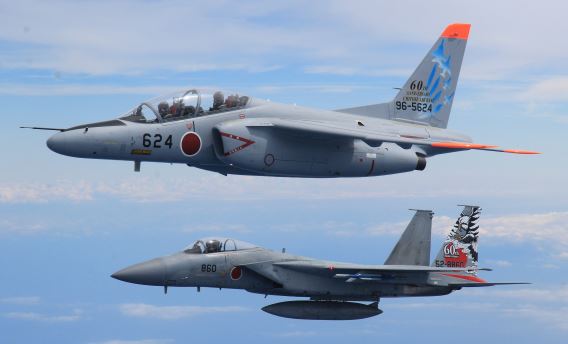 In 2017, two Chitose-based aircraft were painted in special markings to mark the 60th anniversary.
In 2017, two Chitose-based aircraft were painted in special markings to mark the 60th anniversary.
(Photo: JASDF Chitose AB)
 The Chitose base airshow held in August 2016 attracted 76,000 visitors and featured a
The Chitose base airshow held in August 2016 attracted 76,000 visitors and featured a
special stand to commemorate 90 years since that first-ever landing by Hokkai 1.
(Photo from September 15, 2016, issue of base magazine Chitose,
on base website accessed December 16, 2016)
For Chitose AB’s first air show in three years in July 2022, four aircraft the markings carried specially designed for the occasion. That shown below, seen on an F-15J, comprised two discs on a white runway background. The Japanese in the upper disc is the “Connecting people, Connecting the world: Sky Town Chitose” slogan of the City of Chitose’s latest PR campaign, hence the “7th Comprehensive Plan” in English that appeared at the base of the disc.
 (Photo: JASDF Chitose AB via Twitter @jasdf_chitose)
(Photo: JASDF Chitose AB via Twitter @jasdf_chitose)
The self-explanatory 96th Anniversary design commemorated the day in 1926, when local residents of what was then Chitose village cleared a landing field to receive the first civil aircraft seen in the area. More obscurely, the number ‘96’ is also a reference to the year 1996, when a second runway was completed, thereby allowing separate civil-military operations.* A variety of other aviation-themed events were planned to coincide with the air show. Four years to run to the centenary . . .
In something of a surprise move, Chitose AB announced that a T-4 had been assigned to the resident 2nd AW in December 2022 (see Bulletin Board and JASDF Squadron Histories & Markings Part 3).
* See July 19, 2023, Bulletin Board story for 97th anniversary event.
| Chitose AB | |
| Based units | 201st TFS/203rd TFS, 2nd Air Wing (F-15J/DJ, T-4)
701st Sqn, Special Airlift Group (B777-300) Air Rescue Squadron (U-125A, UH-60J) |
| Contact points | Heiwa-mubanchi, Sapporo, Hokkaido 066-8510, Japan
Tel. +81 (0)123-23-3101 ext. 2218 |
| Nearest station | Chitose 千歳 (Chitose Line 千歳線 /JR Hokkaido) |
| Japanese Reference Sources | Base website (last accessed May 16, 2018) Kita no Tsubasa Chitose no Kōkūshi (Northern Wings: An Aviation Wikipedia 千歳基地 |
|
Gifu |
Location | Kakamigahara, Gifu Prefecture |
| Established | (As Army Kakamigahara airfield) 1917 (As JASDF Gifu AB) January 1958 |
What had been established as an Imperial Japanese Army training ground in 1876 became Kakamigahara airfield in 1917.
Requisitioned after the war by the occupying Allied forces, part of the airfield was handed back to Japanese control in 1957 and the remainder in the following year. Gradually, as the main airfield of the JASDF test unit, this mini version of the U.S. Air Force’s Edwards AFB assumed the responsibility for research and development as well as testing, assisted by its location adjacent to a Kawasaki factory.
 Two aerial views of Gifu AB; (above) taken in 1987, that below in June 2011.
Two aerial views of Gifu AB; (above) taken in 1987, that below in June 2011. (Photos: [Top] National Land Image Information [Color Aerial Photographs], Ministry of Land,
(Photos: [Top] National Land Image Information [Color Aerial Photographs], Ministry of Land,
Infrastructure, Transport and Tourism, [above} アラツク, both via Wikimedia Commons)
 The view from the rear seat of an AD&TW F-4EJ on approach to its then home base
The view from the rear seat of an AD&TW F-4EJ on approach to its then home base
(Image from video [link] posted by SDF Gifu Provincial Cooperation Office in
June 2022, via Twitter @gifupco)
 (Above and below) Unusual scenes at Gifu AB on the occasion of its second runway walk event,
(Above and below) Unusual scenes at Gifu AB on the occasion of its second runway walk event,
which was held in November 2021. (See Bulletin Board story) (Photos: [Top] とらちゃvia Twitter @mackytora; [above] Naoki_O via Twitter @naoki_o_0557)
(Photos: [Top] とらちゃvia Twitter @mackytora; [above] Naoki_O via Twitter @naoki_o_0557)
 Over the years, Gifu AB has served as a major repository for retired JASDF aircraft types, although
Over the years, Gifu AB has served as a major repository for retired JASDF aircraft types, although
these have always been left open to the elements. On the service’s active list from October 1961
to January 1973, this H-19C was one such long-standing resident. Seen above in the base
collection area at Gifu in March 1980, its condition had deteriorated to such an extent
that the aircraft was removed in 2004. (Photo above: Takao Kadokami)
 (J-HangarSpace photo taken in October 2000)
(J-HangarSpace photo taken in October 2000)
 少年飛行兵の碑 memorial stone, photographed in October 2012.
少年飛行兵の碑 memorial stone, photographed in October 2012.
(Photo: Hunini via Wikimedia Commons)
 A scene from the November 2023 Gifu air show, which attracted 138,000 visitors. The previous year
A scene from the November 2023 Gifu air show, which attracted 138,000 visitors. The previous year
having been limited to 30,000 chosen by lottery due to the ongoing pandemic, which had forced the
cancellation of the 2020 and 2021 events, this was the first unrestricted air show for four years.
(Photo: JASDF/Gifu AB via X [formerly Twitter] @JASDF_GIFUAB)
| Gifu AB | |
| Based unit | Air Development & Test Wing (various aircraft) |
| Contact points | Nakakanyu-mubanchi, Kakamigahara, Gifu Prefecture 504-8701, Japan
Tel. +81 (0)58-382-1101 Base External Affairs Office ext. 2273 |
| Nearest stations | Kakamigaharashiyakushomae 各務原市役所前 or Mikakino 三柿野 (Meitetsu Kakamigahara Line 名鉄各務原線) |
| Japanese Reference Sources | Base website Base Watching Guide (Ikaros, 1996) Wikipedia 岐阜基地 |
|
Hamamatsu |
Location | Hamamatsu, Shizuoka Prefecture |
| Established | (As IJAAF base) March 1925 (As NSF Aviation School base) Oct. 15, 1952 (As JASDF Hamamatsu AB) Sept. 20, 1955 |
Traditionally a training establishment, Hamamatsu was used as an emergency airfield during the period of the Allied Occupation after World War II.
Following the coming into effect of the Treaty of San Francisco peace accord and the Japan-U.S. Security Treaty on April 28, 1952, the National Security Force was formed on August 1 and set up an aviation school at Hamamatsu on October 15 that same year. Hosting JASDF facilitiess, the base was actually transferred to JGSDF control on July 1, 1954. It was August 1, 1955, when the JGSDF garrison was finally disbanded and September 20, 1955, when Hamamatsu Air Base officially came into existence in its own right.
A selection of photos that was placed on display in a hangar for the JASDF’s 60th anniversary airshow in 2014 provided a glimpse back at bygone eras of the service’s presence at the base.
 An aerial view of Hamamatsu AB, taken in 1988. (Photo: National Land Image Information [Color Aerial
An aerial view of Hamamatsu AB, taken in 1988. (Photo: National Land Image Information [Color Aerial
Photographs], Ministry of Land, Infrastructure, Transport and Tourism via Wikimedia Commons)
| Hamamatsu AB | |
| Based units | 31st/32nd Flying Training Sqn, 1st Air Wing (T-4) 41st Flying Training Sqn, 1st Air Wing (T-400) 602nd Sqn, Airborne Warning & Control Group (E-767) Air Rescue Squadron (U-125A, UH-60J) 1st Technical School (F-2A, F-15J, T-4, T-7) |
| Contact points | Nishiyamacho-mubanchi, Nishi-ku, Hamamatsu, Shizuoka Prefecture 432-8551, Japan
Tel. +81 (0)53-472-1111 PR Group, External Affairs Office, Administration Unit, 1st Air Wing HQ |
| Nearest station | Hamamatsu 浜松 (Tokaido Main Line 東海道本線 /JR East) |
| Japanese Reference Sources | Base website Base Watching Guide (Ikaros, 1996) Wikipedia |
|
Hofu-Kita |
Location | Hofu, Yamaguchi Prefecture |
| Established | (As IJAAF base) April 1944
(As JASDF branch school) 1955 (As JASDF Hofu AB) February 1956 (As JASDF Hofu-Kita AB) June 1959 |
Also requisitioned by the Allies at the end of the war in 1945, what had been opened as an IJAAF airfield just the year before remained under occupation until 1955, when a branch school of the JASDF’s 1st Flying Training School was set up there.
Established in February 1956, Hofu AB was to become JASDF Hofu-Kita (Hofu-North) AB in 1959 and joined by the JGSDF Camp Hofu in 1962. (Formed when the base was divided into two in 1959, the part known as Hofu-Minami [Hofu-South] houses no flight facilities.)
 Three 12th FTW T-34 Mentors parked on the apron at Hofu-Kita, August 1976.
Three 12th FTW T-34 Mentors parked on the apron at Hofu-Kita, August 1976.
(Photo: Akira Watanabe)
 (Photo [July 1994]: Takao Kadokami)
(Photo [July 1994]: Takao Kadokami)
 View of the Hofu-Kita air show, June 2018 (Photo: ほうじ茶 via Twitter @GreenTea_F22)
View of the Hofu-Kita air show, June 2018 (Photo: ほうじ茶 via Twitter @GreenTea_F22)
| Hofu-Kita AB | |
| Based units | 1st/2nd Flying Training Sqn, 12th Flying Training Wing (T-7) |
| Contact points | Tajima-mubanchi, Hofu, Yamaguchi Prefecture 747-8567, Japan
Base External Affairs Office Tel. +81 (0)835-22-1950 ext. 216 Fax: +81 (0)835-22-2085 |
| Nearest station | Hofu 防府 (JR Sanyo Main Line 山陽本線) |
| Japanese Reference Sources | Base website Base Watching Guide (Ikaros, 1996) Wikipedia |
 An opposite-side view of events at the first Hofu AB air show in three years, June 2022. The roof of
An opposite-side view of events at the first Hofu AB air show in three years, June 2022. The roof of
the building on the left was used to provide two socially distanced photographers’ gallery sections,
admission to which cost 10,000 yen and was subject to restrictions, even to the length
(not focal length) of telephoto lenses. (Photo: まくらvia Twitter @makura)
|
Hyakuri |
Location | Omitama, Ibaraki Prefecture |
| Established | (As Hyakurigahara IJNAF base) 1938 (As JASDF Hyakuri Sub-Base) Dec. 25, 1958 (As JASDF Hyakuri AB) July 1966 |
After having been sold off as government property to a war returnee for agricultural use, the local area attracted interest in 1955. The sub-base established in 1958 achieved full base status in 1966.
 Hyakuri, 1974
Hyakuri, 1974
(Photo: National Land Image Information [Color Aerial Photographs], Ministry of Land,
Infrastructure, Transport and Tourism via Wikimedia Commons)
 In November 2004, Hyakuri hosted USAF F-15s from the 67th Fighter Squadron during Exercise
In November 2004, Hyakuri hosted USAF F-15s from the 67th Fighter Squadron during Exercise
Keen Sword 05. (Photo [Nov. 17, 2004]: Master Sgt. Val Gempis/USAF via
U.S. National Archives and Records Administration [NARA])
 A cleaning detail sets about making Hyakuri’s T-33A spick and span on an autumn day
A cleaning detail sets about making Hyakuri’s T-33A spick and span on an autumn day
designated for tidying up the nearby memorials and lawns as well as the base collection aircraft.
(Photo [October 2020]: JASDF/Hyakuri AB via Twitter @jasdf_hyakuri)
 The two groups of pilots in close formation for a commemorative photo at the end of India-Japan
The two groups of pilots in close formation for a commemorative photo at the end of India-Japan
Exercise Veer Guardian 2023; see Bulletin Board January 2023 story.
(Photo: JASDF Hyakuri AB via Twitter @jasdf_hyakuri)
 Taken from the opening shot of a 30-second, 360-degree video (link) filmed on the day of
Taken from the opening shot of a 30-second, 360-degree video (link) filmed on the day of
the Hyakuri air show in December 2023. (やーまん via X @yehman001)
 In memory of Hyakuri’s long association with the reconnaissance Phantom, the tail of
In memory of Hyakuri’s long association with the reconnaissance Phantom, the tail of
an RF-4EKai that was withdrawn from use in October 2012 remains at the base.
(Photo [Dec. 2023]: 颯太 via X @_y4tty_)
| Hyakuri AB | |
| Based units | 3rd TFS (F-2A/B, T-4), 7th Air Wing
Air Rescue Squadron (U-125A, UH-60J) |
| Contact points | Hyakuri 170, Omitama, Ibaraki Prefecture 311-3494, Japan
Tel. +81 (0)299-52-1331 |
| Nearest station | Ishioka 石岡 (Joban Line 常磐線 /JR East) |
| Japanese Reference Sources | Base website Base Watching Guide (Ikaros, 1996) Wikipedia |
|
Iruma |
Location | Sayama, Saitama Prefecture |
| Established | (As IJAAF Irumagawa airfield) December 1938
(As U.S. Army AF Johnson AB) August 1945 (As JASDF Iruma AB) August 1958 |

(Above) The Johnson AAB sign, 1946 (Photo: U. S. Air Force via Wikimedia Commons)
(Below) A map of Johnson AAB (Image ARC432A13 via Wikimedia Commons)
 (Above and below) Pilot Don Lykins, the chairman of the board of the California-based Planes of
(Above and below) Pilot Don Lykins, the chairman of the board of the California-based Planes of
Fame collection, wows the crowd in the Nakajima Ki-84 Hayate (Frank) fighter during its
homecoming display at the Iruma Aerospace Show in October 1973.
(Photos: Takao Kadokami)

 Iruma air show, February 8, 1981 A large crowd of spectators witnesses the Blue Impulse team
Iruma air show, February 8, 1981 A large crowd of spectators witnesses the Blue Impulse team
taxying out for its last ever display on the F-86F. (Photo: Airman First Class Robert Brown/USAF
via U.S. National Archives and Records Administration [NARA])
 Iruma, 1989 (Photo: National Land Image Information [Color Aerial Photographs], Ministry of
Iruma, 1989 (Photo: National Land Image Information [Color Aerial Photographs], Ministry of
Land, Infrastructure, Transport and Tourism via Wikimedia Commons)
 A fine aerial photo of Iruma, taken in mid-November 2021.
A fine aerial photo of Iruma, taken in mid-November 2021.
(Photo: Mayumi via Twitter @Mayumi33825876)
 Iruma tower, November 2006 (Photo: Tokoro_ten via Wikimedia Commons)
Iruma tower, November 2006 (Photo: Tokoro_ten via Wikimedia Commons)
 One of the Iruma’s resident Chinooks undergoes night maintenance in July 2007.
One of the Iruma’s resident Chinooks undergoes night maintenance in July 2007.
(Photo: Tokoro-ten via Wikimedia Commons)
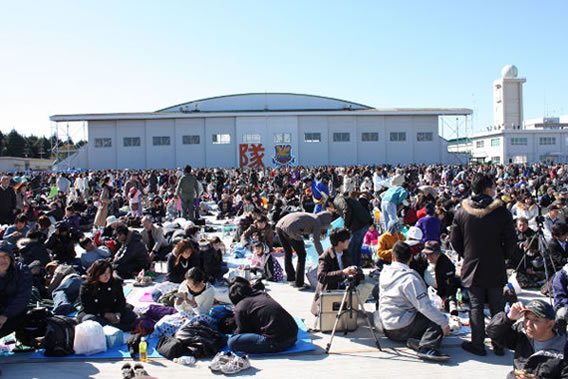
Iruma AB traditionally opens its doors to the public on the November 3 Culture Day holiday every
year. Well served by public transport—a train station is located on the base itself—and a permanent
fixture on the Blue Impulse aerobatic team’s display calendar, the event consistently attracts huge
crowds. Press reports estimated that a record-breaking 325,000 people visited on the day in 2013.
Recording for posterity part of the 320,000-strong crowd at Iruma 2013, a two-minute YouTube video can be viewed here (link). (See the November 5, 2018 Bulletin Board story, Iruma Air Show’s Enduring Appeal.)
 Destined to become a familiar sight in Japanese skies and at the Iruma air show, one of the
Destined to become a familiar sight in Japanese skies and at the Iruma air show, one of the
U-680As is pushed back into the Flight Check Group hangar on the day of its arrival.
(Photo [Mar. 21, 2020]: JASDF/Iruma AB via Twitter)
 Part of the Iruma base collection that is located in front of the Shubudai Memorial Hall
Part of the Iruma base collection that is located in front of the Shubudai Memorial Hall
aviation history museum (Sept. 2012).
From the unlikely source of Kawasaki Bike Magazine’s YouTube channel, a 23-minute film (link) includes footage taken on an April 2023 Iruma base tour. Not surprisingly, the Kawasaki-produced T-4, C-1 and C-2 form the main focus.
Most recently posted on the base’s X (formerly Twitter) feed in September 2023, a short video (link) provides a brief glimpse inside the base museum.
| Iruma AB | |
| Based units | 402nd Sqn, 2nd Tactical Airlift Group (C-1, C-2, U-4)
Central Air Command Support Sqn (T-4, U-4) Electronic Warfare Sqn (EC-1, YS-11EA) Electronic Intelligence Sqn (YS-11EB, RC-2) Flight Check Group (U-125, U-680A) Helicopter Air Transport Sqn (CH-47J) |
| Contact points |
Inariyama 2-3, Sayama, Saitama Prefecture 350-1394 Japan Tel. +81 (0)4-2953-6131 PR Group ext. 2318 |
| Nearest station | Inariyama-koen 稲荷山公園 (Seibu Ikebukuro Line 西武池袋線) |
| Japanese Reference Sources | Base website Base Watching Guide (Ikaros, 1996) Wikipedia |
|
Kasuga |
Location | Kasuga, Fukuoka Prefecture |
| Established | (As IJAAF Mushiroda airfield) May 1945 (As JASDF Kasuga AB) March 1959 |
Although Kasuga became a JASDF base in 1959, its postwar derequisitioning did not officially come to an end until the withdrawal of the last of the U.S. presence in 1972.
The base also maintains flight facilities at part of Fukuoka Airport, which were the former U.S. Air Force’s Itazuke base during the Occupation.
 The U.S. military handed back the Kasugabara residential area in the city of Fukuoka (in the
The U.S. military handed back the Kasugabara residential area in the city of Fukuoka (in the
central foreground in this photo [link]) to Japanese ownership on June 30, 1972. At the time,
the area was home not only to the JASDF base but also to Kasuga City Hall, a park
and other facilities. (JASDF Kasuga AB via Twitter @JASDF_kasuga)
 The unveiling ceremony for the F-1 placed on display at Kasuga AB took place in 2000.
The unveiling ceremony for the F-1 placed on display at Kasuga AB took place in 2000.
(Image: JASDF Kasuga AB via Twitter @kasuga_jasdf)
 Although hardly a high-profile JASDF base, Kasuga does feature a major local landmark
Although hardly a high-profile JASDF base, Kasuga does feature a major local landmark
in the form of a plinth-mounted F-1.
 (Photos: [Top, Sept. 2000] J-HangarSpace;
(Photos: [Top, Sept. 2000] J-HangarSpace;
[above, Jan. 2020]: JASDF/Kasuga AB via Twittter @JASDF_Kasuga)
 Poster for the 60th anniversary base festival, which was held in November 2019. The site
Poster for the 60th anniversary base festival, which was held in November 2019. The site
had begun life in 1940 as the Kokura Army Arsenal Kasuga Manufacturing Plant.
(Image: JASDF Kasuga AB via Twitter @JASDF_kasuga)
 The view across the apron from the Kasuga operations building in December 2021.
The view across the apron from the Kasuga operations building in December 2021.
(Photo: JASDF Kasuga AB via Twitter @JASDF_Kasuga)
 The view in the opposite direction. Standing out against an urban backdrop, the apron and part
The view in the opposite direction. Standing out against an urban backdrop, the apron and part
of the facilities at Kasuga AB. (Photo [Feb. 2024]: SuFlyer via Wikimedia Commons)
| Kasuga AB | |
| Based units | Western Air Defense Force HQ Support Flight Sqn (T-4) Helicopter Air Transport Sqn (CH-47J) |
| Contact points | Haramachi 3-1-1, Kasuga, Fukuoka Prefecture 816-0804, Japan
PR Group, External Affairs Office, Administration Unit, Tel. +81 (0)92-581-4031 ext. 2421 |
| Nearest stations | Kasuga 春日 (Kagoshima Main Line 鹿児島本線 /JR Kyushu)
Kasugabaru春日原 (Nishi Nippon Railroad (Nishitetsu) 西日本鉄道) |
| Japanese Reference Sources | Base website Base Watching Guide (Ikaros, 1996) Wikipedia |
|
Komaki |
Location | Komaki, Gifu Prefecture |
| Established | (As IJAAF Komaki airfield) January 1944 (As JASDF Komaki AB) May 12, 1959 |
Following the familiar procedure, a former IJAAF airfield was requisitioned by the Allies during the Occupation, but in Komaki’s case started to be used as a civilian airport in March 1952, during the Korean War.
Its management was returned to Japanese control in 1958, the year before the JASDF base came into being.
Tragedy struck on March 16, 1960, when a scrambled F-86D collided with an All-Nippon Airlines DC-3 that had just landed on the 2,740-meter shared runway.
KOMAKI OPEN BASE EVENTS
 The Blue Impulse team lined up at the Komaki Open Base event in March 2015. This was
The Blue Impulse team lined up at the Komaki Open Base event in March 2015. This was
reportedly their first appearance there in 44 years, which explains the 73,000 visitors.
(Photo [March 2015]: Chihaya Sta via Wikimedia Commons)
Komaki Open Base Attendance 2016–2019
The weather was fine for each of the five air shows held from 2016 to 2019, and the Blue Impulse team was present for all except the 2018 event.
Mar. 13, 2016 66,000; Mar. 5, 2017 66,000; Mar. 3, 2018 10,000; Mar. 2, 2019 63,000; Nov. 9, 2019 61,000 (2020 cancelled due to COVID-19)
 Soon after the start of the March 2023 Open Base event, the first since November 2019, which
Soon after the start of the March 2023 Open Base event, the first since November 2019, which
attracted 40,000 visitors. Although blessed with clear skies, a chilly wind on the day and the
absence of the Blue Impulse team reduced the number of Open Base 2024
visitors to 21,000. (Photo: Komaki AB via Facebook)
 (Photo via Komaki tourism promotion site [link])
(Photo via Komaki tourism promotion site [link])
 (Photo [May 2024]: JASDF Komaki AB via X @komaki_airbase)
(Photo [May 2024]: JASDF Komaki AB via X @komaki_airbase)
 (Photo taken in February 2014)
(Photo taken in February 2014)
Special Markings
As evidenced by this photo (link), which was taken at the Nyutabaru air show in December 2019, 404th Sqn KC-767 07-3604 at that time carried a Komaki 60th anniversary badge on each of its engine cowlings. Applied in October that year for PR parade purposes at the Gifu and Naha as well as Komaki air shows, the badges were removed early in 2020.
| Komaki AB | |
| Based units | 401st Sqn (C-130H/KC-130H) and 404th Sqn (KC-767), 1st Tactical Airlift Group Air Rescue Wing Training Sqn (U-125A, UH-60J) |
| Contact points | Kasuganji 1-1, Komaki, Gifu Prefecture 485-0025, Japan
Tel. +81 (0)568-76-2191 Base External Affairs Office ext. 4055 |
| Nearest stations | Nagoya 名古屋 (Tokaido Main Line 東海道本線 /JR East) Ushiyama 牛山 (Meitetsu Komaki Line 名鉄小牧線) |
| Japanese Reference Sources | Base website Base Watching Guide (Ikaros, 1996) Wikipedia |
|
Komatsu |
Location | Komatsu, Ishikawa Prefecture |
| Established | (As IJNAF Komatsu air base) July 1944
(As JASDF Komatsu Sub-Base) June 1959 (As JASDF Komatsu AB) Feb. 1, 1961 |
Komatsu Air Show Sept. 22, 1990
Filmed and posted on X (formerly Twitter, by K.otani @kotaken8022), short videos show 8th Sqn F-1 80-8210, sporting a 30th anniversary centreline fuel tank, taxying in and starting up (link), and 306th F-4EJKai 97-8423 in a “scramble” demo, taxying out with 303rd F-15J 82-8903, “remove before flight” tags a-fluttering (link).
More recent Komatsu air shows have attracted huge crowds, but others have had to be cancelled due to terrorist attacks in the United States (2001), an approaching typhoon (2017) or a certain prolonged pandemic (2020 and 2021).
Official attendance figures over the past 10 years: 2013 120,000; 2014 130,000; 2015 147,000; 2016 72,000; 2018 123,000; 2019 125,000; 2022 (to limit numbers, by prior application only) 30,000; 2023 50,000.
 Poster for the Komatsu Air Show 2014, the JASDF’s 60th anniversary year
Poster for the Komatsu Air Show 2014, the JASDF’s 60th anniversary year
 According to reports, the T-34A and T-6G that formed part of the base collection at Komatsu in
According to reports, the T-34A and T-6G that formed part of the base collection at Komatsu in
August 1987 are still present today. At least one application of fresh paint later, the former’s
appearance was much improved in September 2012 (link). (Photo: Takao Kadokami)
The newest addition at Komatsu was a Phantom gate guard in October 2020, as shown below. The hinomaru on its folded starboard wing aptly forming the shape of a heart, F-4EJKai 404 is
The hinomaru on its folded starboard wing aptly forming the shape of a heart, F-4EJKai 404 is
lovingly lowered into position to serve as the guardian of Komatsu’s main gate in early
October 2020. In recognition of the type’s service at the base, which spanned the
years from 1976 to 1997, the aircraft bears the 6th Air Wing’s 303rd TFS
marking on the left side of its tail and that of its 306th TFS on the right. (Photos: JASDF Komatsu AB via Twitter @JasdfKomatsu)
(Photos: JASDF Komatsu AB via Twitter @JasdfKomatsu)
See the Bulletin Board and JASDF Where Are They Now? pages.
 303rd TFS personnel and their Royal Australian Air Force guests pose for a group photo in
303rd TFS personnel and their Royal Australian Air Force guests pose for a group photo in
front of the F-15J painted to commemorate Exercise Bushido Guardian 2023.
See Bulletin Board story Aug.-Sept. 2023.
(Photo: JASDF Komatsu AB via X [formerly Twitter] @JasdfKomatsu)
| Komatsu AB | |
| Based units | 303rd TFS/306th TFS, 6th Air Wing (F-15J/DJ, T-4) Aggressor Sqn, Tactical Fighter Training Group (F-15DJ, T-4) Air Rescue Squadron (U-125A, UH-60J) |
| Contact points | Mukaimoto-orimachi-tsuchinoe 267, Komatsu, Ishikawa Prefecture 923-8586, Japan
Tel. +81 (0)761-22-2101 Base PR Group (External Affairs Office, Administration Unit, 6th Air Wing HQ) ext. 510 |
| Nearest station | Komatsu 小松 (Hokuriku Main Line 北陸本線 /JR West) |
| Japanese Reference Sources | Base website Base Watching Guide (Ikaros, 1996) Wikipedia |
|
Matsushima |
Location | Matsushima, Miyagi Prefecture |
| Established | (As IJNAF base) September 1942
(As U.S. Camp Matsushima) August 1945 (As JASDF base) Nov. 1, 1955 |
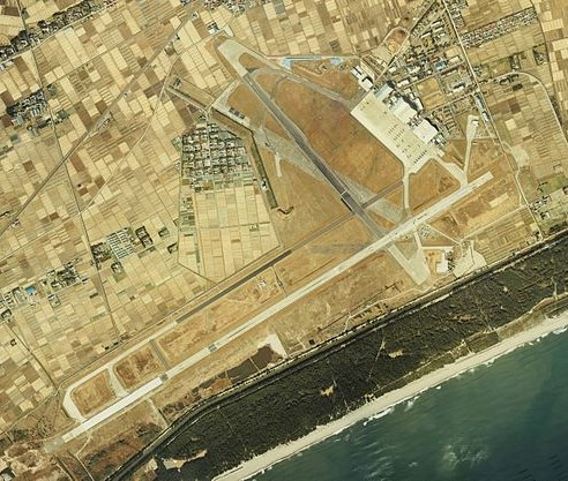 Matsushima, 1984
Matsushima, 1984
(Photo: National Land Image Information [Color Aerial Photographs], Ministry of
Land, Infrastructure, Transport and Tourism via Wikimedia Commons)
| Matsushima AB | |
| Based units | 11th Sqn (Blue Impulse, T-4) / 21st Fighter Training Sqn (F-2B, T-4), 4th Air Wing Air Rescue Squadron (U-125A/UH-60J) |
| Contact points | Itadori-Yamoto 85, Higashi-Matsushima, Miyagi Prefecture 981-0503
Tel. +81 (0)225-82-2111 PR Group (Administration Unit, 4th Air Wing HQ) ext. 211 |
| Nearest station | Yamoto 矢本 (Senseki Line 仙石線 /JR East) |
| Japanese Reference Sources | Base website Base Watching Guide (Ikaros, 1996) Wikipedia |
|
Miho |
Location | Sakaiminato, Tottori Prefecture |
| Established | (As IJNAF base) March 1943
(As British/Indian base during (As JASDF Miho AB) Oct. 1, 1958 |
Originally requisitioned and occupied by the British and Indian forces during the postwar Occupation, Miho was taken over by U.S. elements following the withdrawal of British forces.
In 1955, the JASDF Air Transport Group relocated a detachment of C-46s from Tachikawa to within U.S. Air Force Base Miho, and a joint military-civilian airport terminal was set up the following year. The base was returned to Japanese operational control in 1958, when the detachment of C-46s from Tachikawa formed the nucleus of the Air Transport Wing.
The runway was progressively lengthened from 1,200 metres to 1,500 metres and then in two 500-metre stages to 2,500 metres.
 The logo for Miho AB’s 60th anniversary incorporates a slogan that translates as:
The logo for Miho AB’s 60th anniversary incorporates a slogan that translates as:
60 years of keeping in step with the local area—from Miho to the skies around the world.
 Miho AB and the surrounding area seen from a C-2 during an air experience flight organized for
Miho AB and the surrounding area seen from a C-2 during an air experience flight organized for
local residents in October 2022. (Photo: JASDF Miho AB via Twitter @MIHO_AB)
| Miho AB | |
| Based units | 403rd Sqn (C-2) / 405th Sqn (KC-46A) |
| Contact points | Koshinozucho 2258, Sakaiminato, Tottori Prefecture 684-0053, Japan
Tel. +81 (0)859-45-0211 ext. 211 |
| Nearest stations | Oshinozucho or Nakahama 大篠津町・中浜 (Sakai Line 境線 /JR West) |
| Japanese Reference Sources | Base website (last accessed May 16, 2018) Base Watching Guide (Ikaros, 1996) Wikipedia |
|
Misawa |
Location | Misawa, Aomori Prefecture |
| Established | (As IJNAF base) Feb. 1942 (As joint U.S.-Japanese base) August 1958 |
 Misawa, 1975
Misawa, 1975
(Photo: National Land Image Information [Color Aerial Photographs], Ministry of Land,
Infrastructure, Transport and Tourism via Wikimedia Commons)
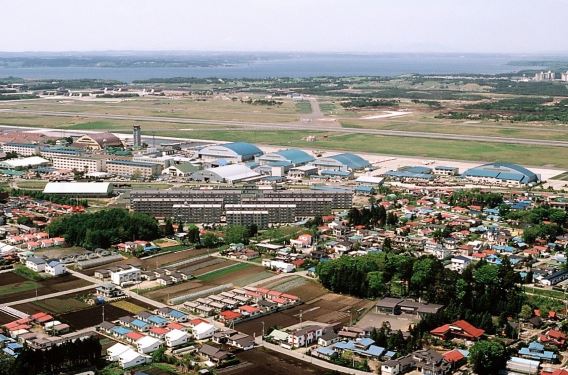 (Photo [May 14, 1990]: Tech. Sgt. James Furgerson/USAF via
(Photo [May 14, 1990]: Tech. Sgt. James Furgerson/USAF via
U.S. National Archives and Records Administration [NARA])
 The air show held at Misawa on September 8, 2019, attracted some 95,000 visitors.
The air show held at Misawa on September 8, 2019, attracted some 95,000 visitors.
(Photo: JASDF Misawa AB)
| Misawa AB | |
| Based units | 301st TFS / 302nd TFS, 3rd Air Wing (F-35A/T-4) 601st Sqn, AEW Surveillance Group (E-2C, E-2D) Helicopter Air Transport Sqn (CH-47J) |
| Contact points | Ushirokubo 125-7, Misawa, Aomori Prefecture 033-8604, Japan
Tel. +81 (0)176-53-4121 |
| Nearest station | Misawa 三沢 (Tohoku Main Line 東北本線 /JR East) |
| Japanese Reference Sources | Base website Base Watching Guide (Ikaros, 1996) Wikipedia |
 Previously at Nyutabaru (see the Nyutabaru Base History page), the tail of 301st Sqn
Previously at Nyutabaru (see the Nyutabaru Base History page), the tail of 301st Sqn
F-4EJKai 27-8305 was unveiled at Misawa on March 17, 2023.
(Photo: JASDF Misawa via X [formerly Twitter] @jasdf_misawa)
|
Naha |
Location | Naha, Okinawa Prefecture |
| Established | (As IJNAF Oroku airfield) 1933
(As Naha civil-military airfield) 1936 (Reverted to IJNAF Oroku airfield) 1942 (Occupied as U.S. military base) June 1945 (As JASDF Naha AB) October 1972 |
What started life as IJNAF Oroku airfield in 1933 became the joint civil-military Naha airfield in 1936. When Okinawa came under U.S. control following the end of the Pacific War, the site gradually returned to joint use only with a U.S. military presence.
The establishment of a JASDF base was enabled by the return of part of the airfield under the terms of the 1972 Okinawa Reversion Agreement, by which Okinawa was, after 27 years, returned to Japanese rule. Quick reaction alert operations with based JASDF Starfighters commenced the following year, but it was to be 1982 before the remainder of the base area was handed back to the then Japan Defense Agency.
The base runway was extended to 3,000m (9,840 feet) in 1986, the year after the Starfighters had made way for Phantoms. The first F-15Js arrived in 2009, and a two F-15J squadron system has been operated since January 1, 2016.
As the runway is now used for JASDF, JMSDF, Japan Coast Guard as well as increasing levels of airline operations, plans for an alternate runway to be built along the lines of the reef runway at Honolulu airport in Hawaii were being studied in 2016.
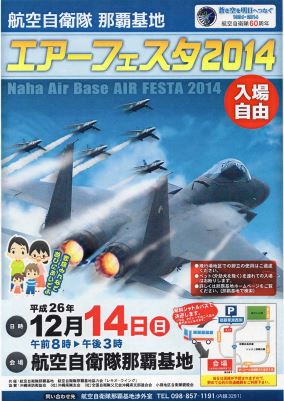 Naha AB traditionally holds its annual airshow in December.
Naha AB traditionally holds its annual airshow in December.
 The Naha air show in December 2022 brought down the curtain on a gradual post-COVID
The Naha air show in December 2022 brought down the curtain on a gradual post-COVID
revival of air shows in Japan. (Photo: JMSDF 5th Fleet Air Wing via Twitter @jmsdf_5aw)
| Naha AB | |
| Based units | 204th Sqn / 304th Sqn, 9th Air Wing (F-15J/DJ, T-4) Southwestern Air Defense Force Support Flt (T-4) 603rd Sqn, Airborne Warning & Control Group (E-2C) Helicopter Air Transport Sqn (CH-47J) Air Rescue Squadron (U-125A, UH-60J) |
| Contact points | Toma 301, Naha, Okinawa Prefecture 901-0144, Japan
Tel. +81 (0)98-857-1191 Base External Affairs Office, PR Group ext. 3291 |
| Nearest station | (Transport links to/from Naha Port 那覇港 and Naha Airport 那覇空港) |
| Japanese Reference Sources | Base website Base Watching Guide (Ikaros, 1996) Wikipedia |
|
Nara |
Location | Nara, Nara Prefecture |
| Established | March 1957 |
Located about 50 km (30 miles) east of Osaka and the sole JASDF base in the Kansai region, runway-less Nara was returned to Japanese control after its former resident U.S. Army units vacated in March 1957. Soon thereafter, the site became the permanent home of the JASDF Air Officer Candidate School (AOCS), which had itself been formed at Hofu in September 1955. The opportunity was also taken to bring under the same roof a Hamamatsu officer training centre that dated back to December 1954.
 An aerial view of Nara AB shows the treed area containing its aircraft collection* in the central
An aerial view of Nara AB shows the treed area containing its aircraft collection* in the central
foreground and the adjacent key-shaped Uwanabe Kofun (burial mound) archaeological site.
(Photo [from Sept. 2017]: Japan Ministry of Defense via Wikimedia Commons)
Many of Nara’s students are those on the JASDF stream who have already successfully passed out from Japan’s tri-service National Defense Academy in Yokosuka, Kanagawa Prefecture, at the culmination of a four-year, university-level course; others are graduates from civilian universities or JASDF members being promoted internally. The aircraft collection* is primarily maintained to educate and inspire as well as to raise awareness of the JASDF’s traditions among the student trainees, the 112th course of which graduated in October 2022.
Guided tours of the base take in the two-level Shōrin-en (literally ‘Pine Forest Garden’) archives. The exhibits here range from wartime memorabilia in one area to aircraft parts and engines in another; there are also display cases of wartime and JASDF aircraft models as well as of replica missiles. Space is also given over to an exhibition of the JASDF elements that were sent in support of the reconstruction efforts in Iraq from 2004 to 2008.
Display case exhibits include two that contain items from two famous Japanese pilots: Kiyotake Shigeno (1882–1924), who served as a fighter pilot with the French Air Force in World War I; and Tateo Katō (1903–1942), Army ace fighter pilot most often associated with the Hayabusa-equipped 64th Flight Regiment, which he commanded.
Another display case concerns an airman who was killed in action in the Pacific War: Yoshio Masumi 桝見良雄
Born in Fukuoka Prefecture in October 1920, Masumi graduated in law from Waseda University, Tokyo, in August 1943 and joined the 13th intake to the Navy reserve student course two months later. Having served as an ensign with the 254th and as a lieutenant (junior grade) observer with the 25th Naval Air Squadron, Masumi was assigned to a special attack (kamikaze) unit when one of the crew of a B6N Tenzan (Jill) lost off Okinawa during Operation Kikusui (Floating Chrysanthemum) on April 6, 1944. He was posthumously promoted to the rank of lieutenant.
(Dedicated to the 27 crew members who were senselessly killed in action in the nine Floating Chrysanthemum Tenzan Unit aircraft deliberately lost that day, a monument was erected by the Bereaved Families’ Association at a temple in Setagaya, Tokyo, in December 1961.)
Also on display is a buckled propeller blade from the Nakajima Ki-44 Shoki fighter flown by Sgt Kenichi Kumagaya of the then Kashiwa, Chiba Prefecture-based 70th Flight Regiment, who was killed after ramming a B-29 on December 27, 1944. Having come down in Kameido, Taito-ku, Tokyo, his aircraft was excavated in 1970 and a memorial erected at the site.
 A group of visitors passes through part of the Shōrin-en base archives building during a guided tour
A group of visitors passes through part of the Shōrin-en base archives building during a guided tour
conducted in June 2022. Judging from this image, it could be that photography and the carrying of
bags are no longer permitted on the tour, which depending on numbers lasts up to two hours.
(Photo: JASDF Naha AB via Twitter @JASDF_Nara)
As reported on the base Twitter feed, Nara AB received a special visitor on February 13, 2023. Now aged 92, Yasuhiro Yoshizoe would have been in his mid-20s when he was one of those in the OCS’s first student intake in 1957.
 On his first return visit in 65 years, Nara OB (Old Boy) Yasuhiro Yoshizoe (92)
On his first return visit in 65 years, Nara OB (Old Boy) Yasuhiro Yoshizoe (92)
visits Nara AB’s Shōrin-en archives in February 2023. The photos behind him
show (top) the main gate of the then Ministry of Health and Welfare labour
training centre that first occupied the site, opening on April 1, 1942,
and below that the main gate on the day the air base’s first
administrative building was opened for operations in 1957.
(Photo: JASDF Naha AB via Twitter @JASDF_Nara)
Limited Flying Displays
Short solo flying displays by one or two aircraft are usually organized for full open days. Exceptions were the participation of six aircraft (a C-130H, F-2, F-15J, KC-767, U-125, and a UH-60J) in the JASDF’s 50th anniversary year in 2014—so something similar can be expected in 2024—and a Blue Impulse display that took place to mark Nara AB’s 60th anniversary in November 2016.
In the absence of car parking, for anyone wishing to visit an event or join a guided tour (application possible via the base website**) public transport is the way to go. In June 2023, the options included the following buses:
JR Nara Station’s West Exit: From stop No. 15, bound for Yamato-Saidaiji (大和西大寺)
Kintetsu Nara Station: From stop No. 13, also bound for Yamato-Saidaiji
Kintetsu Yamato-Saidaiji Station’s North Exit: From stop No. 1, bound for JR Nara Station
In all these cases, get off at the bus stop simply named Kōkūjieitai (航空自衛隊, Air Self-Defense Force).
 Having been appointed in September 2021, the outgoing OCS head Maj Gen Mitsunobu Yamamoto
Having been appointed in September 2021, the outgoing OCS head Maj Gen Mitsunobu Yamamoto
fulfills one of his final duties by paying his respects at the base cenotaph. Out of shot to the right
is a stone, erected on August 21, 1998, which bears the kanji 翔 (shō), meaning fly or soar.
Yamamoto was leaving to take up his new position as Gifu AB commander the following month.
(Photo [Dec. 2022]: JASDF Naha AB via Twitter @JASDF_Nara)
* Information about the Nara AB aircraft collection can be found in a March 2023 story on the Bulletin Board page.
** Guided Tour website pages (Japanese) [link] [link]
| Nara AB | |
| Based unit | None (no runway) |
| Contact points | Hokkejicho 1578, Nara City, Nara Prefecture 630-8522, Japan Tel. +81 (0)742-33-3951 ext. 314 Website homepage/2023 (link) |
| Nearest stations | JR Nara Station; Kintetsu Nara/Yamato-Saidaiji stations |
| Japanese Reference Sources | Base website (last accessed Apr. 22, 2023)
Wikipedia 奈良基地 |
|
Niigata |
Location | Niigata Airport, Niigata City, Niigata Prefecture |
| Established | (As Niigata municipal airport) 1929
(As U.S. military base under Occupation) 1945 (As JASDF Niigata Sub-Base) Nov. 20, 1962 |
 (Photo [posted Feb. 2021]: JASDF Niigata Sub-Base via Twitter @jasdf_niigata)
(Photo [posted Feb. 2021]: JASDF Niigata Sub-Base via Twitter @jasdf_niigata)
 (Photo: JASDF Niigata Sub-Base)
(Photo: JASDF Niigata Sub-Base)
 (Photo [posted Nov. 2020]: JASDF Niigata Sub-Base via Twitter @jasdf_niigata)
(Photo [posted Nov. 2020]: JASDF Niigata Sub-Base via Twitter @jasdf_niigata)
| Niigata Sub-Base | |
| Based unit | Air Rescue Squadron (U-125A/UH-60J) |
| Contact points | 135, Funaecho 3, Higashi-ku, Niigata City, Niigata Prefecture 950-0031, Japan
Tel. +81 (0)25-273-9211 Base PR Group ext. 206 Fax +81 (0)25-273-9211 ext. 207 |
| Nearest station | Niigata 新潟 (Shinetsu Line 信越本線 /JR East) |
| Japanese Reference Sources | Base website Base Watching Guide (Ikaros, 1996) Wikipedia |
|
Nyutabaru |
Location | Shintomi Town, Miyazaki Prefecture |
| Established | (As IJAAF Nyutabaru airfield) 1940
(As U.S. military base under Occupation) August 1945 (As JASDF base) Dec. 1, 1957 |
Constructed as an IJAAF airfield just prior to the outbreak of hostilities in the Pacific, Nyutabaru was sold off as agricultural land after the end of the war only to be rebuilt in 1957. The first aircraft, a T-33A, landed at the new air base on February 1, 1958.
 Nyutabaru, 1974
Nyutabaru, 1974
(Photo: National Land Image Information [Color Aerial Photographs], Ministry of Land,
Infrastructure, Transport and Tourism via Wikimedia Commons)
 (Photo [undated]: JASDF Nyutabaru)
(Photo [undated]: JASDF Nyutabaru)
 First F-4EJKai (Photo: JASDF Nyutabaru)
First F-4EJKai (Photo: JASDF Nyutabaru)
 (Photo [Nov. 1997]: Takao Kadokami)
(Photo [Nov. 1997]: Takao Kadokami)
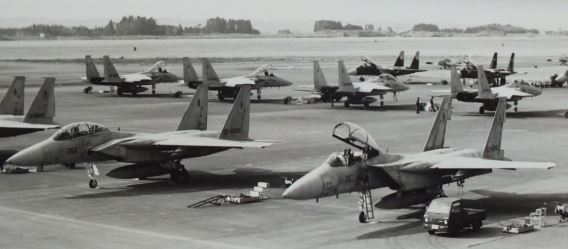 Nyutabaru flight line, January 1994 (Photo: Takao Kadokami)
Nyutabaru flight line, January 1994 (Photo: Takao Kadokami)
 A well-attended photo call marks the final flight of a T-33A from Nyutabaru in July 1994.
A well-attended photo call marks the final flight of a T-33A from Nyutabaru in July 1994.
In the background are representative aircraft from each of the three then resident units
(from left to right): 301st TFS, Tactical Fighter Training Group and 202nd Sqn.
(Photo: JASDF Nyutabaru AB)
 (Above and below) For the base air show held in December 2002, a 23rd Sqn F-15J was specially
(Above and below) For the base air show held in December 2002, a 23rd Sqn F-15J was specially
painted to draw attention to Nyutabaru’s 45th anniversary. (Photos: Takao Kadokami)
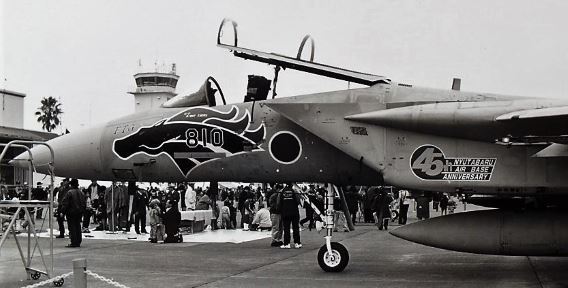
 Nyutabaru tower, November 1997 (Photo: Takao Kadokami)
Nyutabaru tower, November 1997 (Photo: Takao Kadokami)
 Nyutabaru tower, December 2008 (Photo: Sanjo via Wikimedia Commons)
Nyutabaru tower, December 2008 (Photo: Sanjo via Wikimedia Commons)
 Aircraft from the Nyutabaru base collection brought out for display purposes in
Aircraft from the Nyutabaru base collection brought out for display purposes in
November 1997 (above) and on their permanent site in December 2008.
 (Photos: Takao Kadokami)
(Photos: Takao Kadokami)
 Visible to the right of the base collection’s F-104J is the reverse side of a black stone monument
Visible to the right of the base collection’s F-104J is the reverse side of a black stone monument
dedicated to and bearing the personnel names of the former 202nd Sqn, which disbanded in
October 2000, the month before this photo was taken. The big rock seen next to the sign
in front of the aircraft marks the birthplace (or cradle) of the 204th Sqn.
(For more information on the aircraft itself, see Displayed Aircraft Special Report 1 on the
JASDF Where Are They Now? page.)
 (Photo [posted Feb. 2021]: JASDF Nyutabaru AB via Twitter @JASDF_nyutabaru)
(Photo [posted Feb. 2021]: JASDF Nyutabaru AB via Twitter @JASDF_nyutabaru)
 The vertical tail from Phantom 17-8305 was erected with a plaque at Nyutabaru in 2013 to
The vertical tail from Phantom 17-8305 was erected with a plaque at Nyutabaru in 2013 to
commemorate the 40th anniversary of the formation of the 301st Sqn; 301’s tail was
inconveniently in use until the very end. Here shown after having been repainted
and reinstalled by 305th TFS maintenance personnel in 2021, the monument
eventually followed the 301st to Misawa early in 2023.
(Photo: JASDF Nyutabaru AB via Twitter @JASDF_Nyutabaru)
 301st TFS F-4EJ 7-8305 when engineless but still intact, on a wet Nyutabaru air show day
301st TFS F-4EJ 7-8305 when engineless but still intact, on a wet Nyutabaru air show day
in December 2005. (Photo: エアスピリッツ via X @air_spirits)
| Nyutabaru AB | |
| Based units | 305th TFS, 5th Air Wing (F-15J/DJ, T-4)
23rd Fighter Training Sqn, Tactical Fighter Training Group (F-15DJ, T-4) Air Rescue Squadron (U-125A, UH-60J) |
| Contact points | Oaza Nyuta 19581, Shintomi Town, Koyu District, Miyazaki Prefecture 889-1492, Japan
Tel. +81 (0)983-35-1121 Base PR Group ext. 5293 |
| Nearest station | Hyuga-Shintomi 日向新富 ((Nippo Main Line日豊本線 /JR Kyushu) |
| Japanese Reference Sources | Base website Base Watching Guide (Ikaros, 1996) Wikipedia |
|
Shizuhama |
Location | Yaizu, Shizuoka Prefecture |
| Established | (As IJNAF Fujieda air base) January 1945 (As JASDF Shizuhama AB) August 1958 |
 (Photo [May 2015]: Leonis via Twitter [@ipad_02])
(Photo [May 2015]: Leonis via Twitter [@ipad_02])
 (Photo [undated]: S. Nishibayashi/JASDF Shizuhama AB via website)
(Photo [undated]: S. Nishibayashi/JASDF Shizuhama AB via website)
 The logo adopted for Shizuhama AB’s 60th anniversary
The logo adopted for Shizuhama AB’s 60th anniversary
(Design: Tomoya Tanaka)
| Shizuhama AB | |
| Based units | 1st and 2nd Sqn, 11th Flying Training Wing (T-7) |
| Contact points | 1602, Kamikosugi, Yaizu,
Shizuoka Prefecture 421-0293, Japan Tel. +81 (0)54-622-1234 11th FTW External Relations Office (ext. 406) |
| Nearest station | Fukieda 藤枝 (Tokaido Main Line東海道本線 /JR East) |
| Japanese Reference Sources | Base website (last accessed May 15, 2018) Base Watching Guide (Ikaros, 1996) Wikipedia |
|
Tsuiki |
Location | Chikujo Town, Fukuoka Prefecture |
| Established | (As IJNAF base) October 1942 (As U.S. military base under Occupation) October 1946 (As JASDF base) Oct. 1, 1957 |
Tsuiki was yet another of the former military bases requisitioned by the occupying forces at the end of the war in the Pacific.
The nascent JASDF moved in while the base remained under U.S. control in 1954 and commenced jet training on T-33As the following year and F-86Fs in 1956. Tsuiki was returned to Japanese control on October 1. 1957.
 Aircraft from the short-lived 16th Flying Training Wing parked on the ramp at
Aircraft from the short-lived 16th Flying Training Wing parked on the ramp at
Tsuiki in December 1962. (Photo: Takao Kadokami)
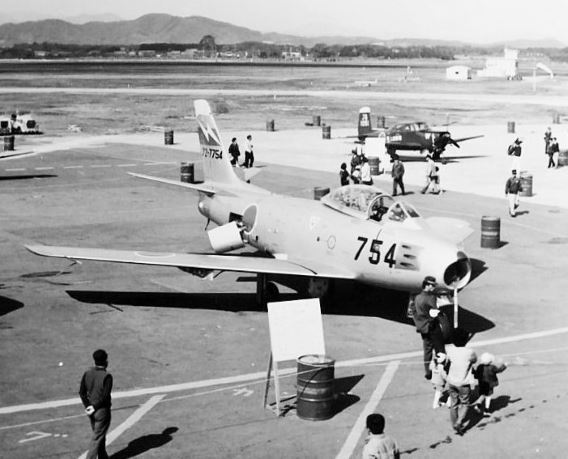 (Above and below) Two views overlooking the open day event held at Tsuiki on November 7, 1971.
(Above and below) Two views overlooking the open day event held at Tsuiki on November 7, 1971.
(Photos: Takao Kadokami)

 Tsuiki, 1974
Tsuiki, 1974
(Photo: National Land Image Information [Color Aerial Photographs], Ministry of Land,
Infrastructure, Transport and Tourism via Wikimedia Commons)
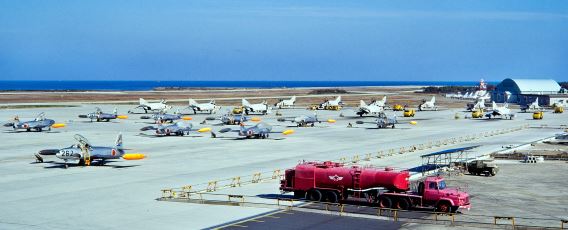 A typically spectacular shot across Tsuiki, taken during a period of construction in early December
A typically spectacular shot across Tsuiki, taken during a period of construction in early December
1979. A visiting T-33A from the Iruma-based Central Air Command HQ Sqn (left) has joined the
T-33As and F-4EJs of the 6th and 304th squadrons, respectively. In the distance, a lineup of
6th Sqn F-86Fs with their canopies covered. (Photo: Akira Watanabe)
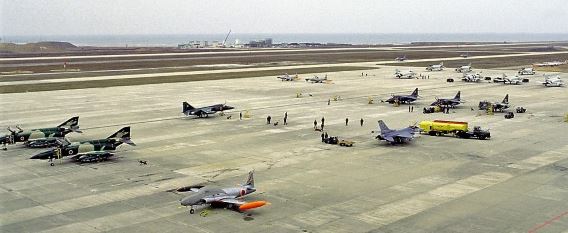 The Tsuiki flight line during Exercise Cope North 89-2
The Tsuiki flight line during Exercise Cope North 89-2
(Photo [Feb. 27, 1989]: Staff Sgt. Theodore J. Koniares/USAF via
U.S. National Archives and Records Administration [NARA])
Tsuiki 50th Anniversary, November 8, 1992
 A representative of each of the trainer types was given special markings for the occasion.
A representative of each of the trainer types was given special markings for the occasion.
 (Photos: Takao Kadokami)
(Photos: Takao Kadokami)
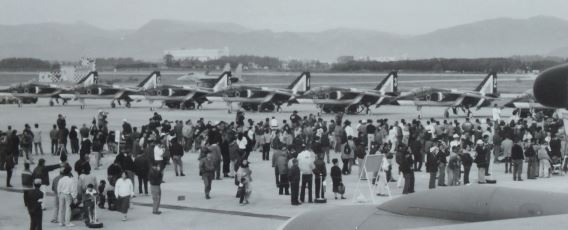 The Blue Impulse team at Tsuiki, November 19, 1995, for their third to last T-2 display before
The Blue Impulse team at Tsuiki, November 19, 1995, for their third to last T-2 display before
converting to the T-4. (Photo: Takao Kadokami)
 Tsuiki opens its flood gates, November 26, 2017. Nowadays, on years when the Blue Impulse
Tsuiki opens its flood gates, November 26, 2017. Nowadays, on years when the Blue Impulse
team’s presence is announced, visitor attendance reaches around 50,000.
(Photo: JASDF Public Affairs Office via Twitter @JASDF_PAO)
 For many years home to the F-15J Eagles of the 304th TFS (above) and the F-2A/B-equipped
For many years home to the F-15J Eagles of the 304th TFS (above) and the F-2A/B-equipped
6th TFS, Tsuiki AB is scenically situated on the coast of Fukuoka Prefecture. Seen here in
September 2000, the 304th relocated to Naha AB in January 2016.
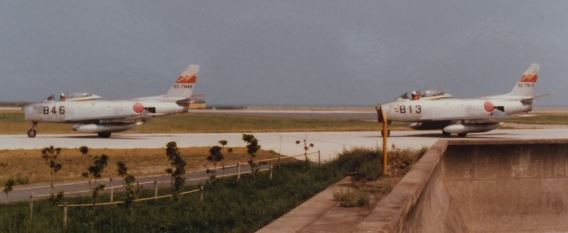
(Above and below) Two photos taken at Tsuiki seven years apart. In August 1978, a pair of based
6th Sqn F-86Fs taxis by the concrete sea wall structure that is an identifying feature at Tsuiki; in
November 1985, a trio of 302nd Sqn F-4EJs arrives at the other end of the runway, canopies
open for ventilation, on the day the unit moved from Chitose to Naha. (Photos: Takao Kadokami)
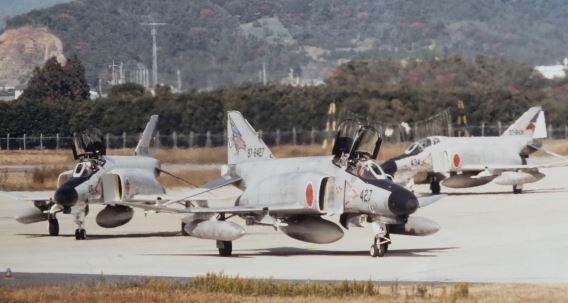
 (Photo [Oct. 2012]: Takao Kadokami)
(Photo [Oct. 2012]: Takao Kadokami)
 A Tsuiki AB welcoming committee greets the arrival of the former Air Development & Test Wing
A Tsuiki AB welcoming committee greets the arrival of the former Air Development & Test Wing
F-4EJ 07-8429, which is due to be placed on display.
(Photo [Mar. 15, 2021] JASDF Tsuiki AB via Twitter @jasdf_tsuiki)
 Delivered to the 1st Air Wing in September 1959, F-86F 92-7922 was with the 8th Air Wing’s 10th
Delivered to the 1st Air Wing in September 1959, F-86F 92-7922 was with the 8th Air Wing’s 10th
Sqn when withdrawn for operational service in May 1976, less than a year before that squadron
was itself disbanded. Photos show the aircraft displayed at JGSDF Beppu Army Camp in August
1979 and in November 1982 (link), after having been one of four aircraft given experimental
camouflage schemes to find the most suitable colour combination for the C-1 and F-1.
Having been on display intact at Tsuiki in 1986, at some unknown point just its mose
section was placed in the base’s PR centre (photo from Nov. 2004 [link]).
(Photo [Feb. 2024]: JASDF Ashiya AB via X @jasdf_ashiya)
| Tsuiki AB | |
| Based units | 6th TFS / 8th TFS, 8th Air Wing (F-2A/B, T-4) |
| Contact points | Nishihattabanchi, Chikujo Town, Chikujo District
Fukuoka Prefecture 829-0151, Japan Tel. +81 (0)930-56-1150 Base External Relations Office (ext. 443, 207) |
| Nearest station | Tsuiki 築城 (Nippo Main Line日豊本線 /JR Kyushu) |
| Japanese Reference Sources | Base website Base Watching Guide (Ikaros, 1996) Wikipedia |
(All photographs on this website are copyright J-HangarSpace
unless otherwise stated.)


